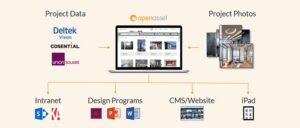The Growing Role of DAM in Modern AEC Marketing
Jun 10, 2019

We live in a tech-charged, click and share world. Which means that if you have any involvement in marketing or sales at an AEC firm, two things are true: You have an ever-growing cache of digital image assets. And you have more channels to share those assets than ever before, from presentations and proposals to your website and social media channels.
According to OpenAsset’s recent research, 52% of AEC firms maintain image libraries sized well over 20K assets. And 56% of firms say they will create more or a lot more images this year than last. (To read more about the image issue and how AEC firms are addressing it, check out our e-book, State of Digital Asset Management in AEC.)

But despite the proliferation of image assets available, and the growing demand among clients to see detailed photography illustrating your project experience, many marketers revert to using the same images over and over because they simply don’t have the time to search for and find project photos.
That’s where a digital asset management solution can help.
Our research shows that firms that have not invested in a DAM are the most likely to say that fewer than 50% of their image asset can efficiently be found and used. Part of the problem is that marketing teams, sales teams, and project teams tend to store their assets in separate places, usually in file folders shared throughout the office or company, which tend to get disorganized. Those who are searching for images don’t always have easy access, or even know they exist.
On the other hand, companies that have a DAM and a digital asset manager are much more likely to say that over 75% of images can be quickly accessed and used. As a single and centralized photo library, a DAM affords easier and faster image access not just to marketers, but to partners and principals, the business development team, project managers, and others. In fact, DAM users typically open up image access to more people in their organization, because with DAM, product owners can control how images are used and who has access to which images.

As a result, DAM users say they benefit from much greater marketing productivity and operational efficiency, and that marketing is cleared as a production bottleneck in their firms. They benefit from automated, efficient workflow that enables faster, easier production of capabilities packages, case studies, RFP and tender responses, and all the other items on their growing list of deliverables.
When firms select a DAM that is project-based, the outcome gets even better.
Of course, not all DAMs are created equal. A DAM that is project-focused is more likely to better meet the needs of AEC firms because it allows users to organize images around the projects they market.
A DAM with project folders, automated project keyword capabilities, and the ability to connect with your ERP and tag assets with project metadata—including client, services rendered, discipline, and location—makes it that much easier for marketers and others in the firm to find and use the images they need. Images can be easily and automatically tagged and categorized, and people can search for all assets related to specific project or category of projects. With a project-based DAM, you also enjoy easy access to the other essential details about the project, including budget, project description, and team members. For more information about selection a DAM, check out this blog post on how to get started.
So if your firm is looking for a way to take control of its digital assets to better showcase its project expertise (and what AEC firm isn’t?), then a project-based DAM may be just the answer. With the system in place, the next time anyone in your firm needs images related to specific project, the assets they need will be just a click away.





